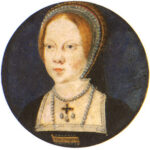Gloucester: February 9 1555. A small fire is kindled starting slowly but gradually raising to an inferno at the heart of which stands John Hooper. Who, “knocked his breast with his hands until one of his arms fell off, and then knocked still with the other, while the fat, water, and blood dropped out at this finger’s ends…”[1] Oxford: October 15, 1555.
A fire rages hot outside of the Bacardo gate, at the center of which stands Bishop Hugh Latimer. “His body forcibly penetrated by the fire,” his “blood [flowing] abundantly from the heart; as if to verify his constant desire that his heart’s blood might be shed in defense of the Gospel.”[1] With the ascension of Mary to the throne, England was plunged into a violent and bloody religious turmoil.
A pure Catholic at her core, Mary immediately began to turn England from the Protestantism that had flowered under Edward VI, the Acts of Uniformity, and ideas such as the Book of Common Prayer, and return the nation to, as she stated in a letter to Oxford University, “[the] form and order…according to the ancient foundations and ordinances of the founders and grants of our progenitors,”[3] meaning-of course-Catholicism.
This meant different things for different people. For John Hooper and Hugh Latimer it meant the martyrdoms they received as illustrated above by John Foxe in his Acts and Monuments commonly known as The Book of Martyrs. For others not willing or wanting to become martyrs, it meant either leaving England, as Jon Knox did and becoming one of the many Marian Exiles, or living a secret live as one of nicodemites such as Sir William Cecil and Sir John Cheke elected to do.
However, for others such as Reginald Pole and Stephen Gardiner it meant a return to England-and power. Reginald Pole, as we find in “The English Reformation,” was sent by the Pope as the “Cardinal and papal legate for the restoration of England to Catholic obedience.”
[4] Upon his arrival to England Mary quickly allowed him the position of the Archbishop of Canterbury, seeing as the former Bishop, Thomas Cranmer, had previously been burned at the stake. Stephen Gardiner although never leaving England, as he was somewhat impeded in doing so due to his imprisonment in London Tower, returned to power when Mary released him and made him the Bishop of Winchester and also the Lord Chancellor.
Even though Mary and her court did many things to root out Protestantism such as repealing all the Protestant changes made under Edward the VI, officially recognizing the Pope again, reinstating the heresy laws, and performing a series of royal visitations to ensure that all went according to plan, they were not wholly successful in their endeavor to return England to Catholicism. Nevertheless, there was definitely an impact made on the lives of the populace as shown in the will of Sir John Porte of Etwall.
Returning to ideas and beliefs found in the first version of his father’s will, he asks people to take charge of the praying for his and his family’s souls and makes arrangements for such to happen. [5] Whether or not his conformity to Catholicism is true conversion or only skin deep is, of course, questionable and hard to know. However, what is known is that Mary’s reign was one fraught with religious turmoil, death, violence, and vast amounts of blood, in which all men and women were forced to make decisions about their faith and what it truly meant to them. Would they choose to be a nicodemite? A Marian Exile? Convert to Catholicism? Or take the final test of faith as a martyr?
[1] John Foxe, “Bishop Ridley and Bishop Latimer” in BOOK OF MARTYRS at http://www.ccel.org/f/foxe_j/martyrs/fox116.htm
[2] “The History, Imprisonment, and Examination of Mr. John Hooper, Bishop of Worcester and Gloucester” in John Foxe, The Book of Martyrs at http://www.ccel.org/f/foxe_j/martyrs/fox116.htm
[3] British Library, Additional Ms. 32091, fo. 145. Queen Mary to Oxford University, 20 Aug., 1 Mary. Sign Manuel. Transcribed by Norman Jones.
[4] Norman Jones, The English Reformation Religion and Cultural Adaptation (Oxford: 2002), 45.
[5] Will of Sir John Porte of Etwall, Derbyshire. Henry E. Huntington Library, HAP Box 9, folder 4, transcribed by Norman Jones.




